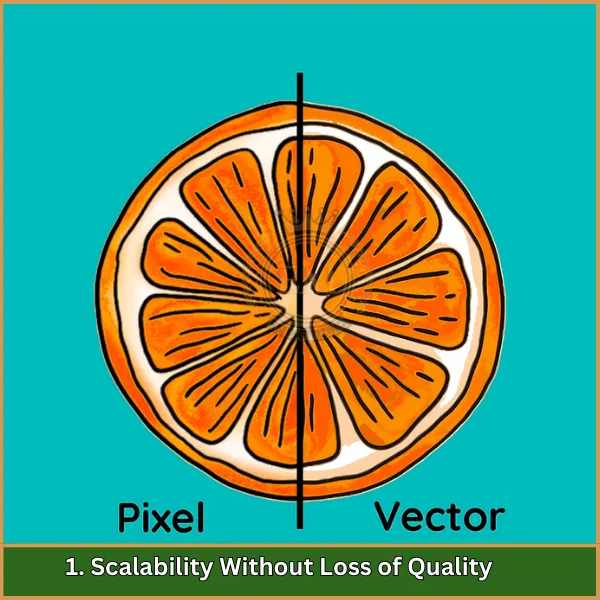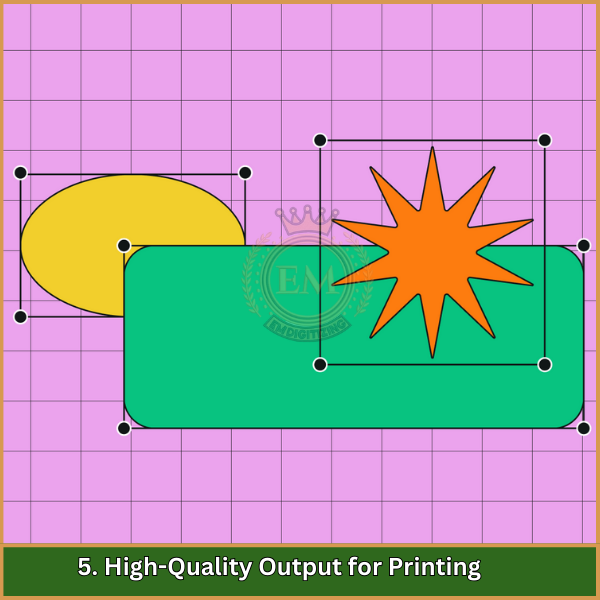Quando si tratta di design, Conoscere i vantaggi e gli svantaggi delle immagini vettoriali può fare una grande differenza. Sono amati per la loro capacità di ridimensionare senza perdere chiarezza, making them perfect for projects like logos and icons.
Tuttavia, they do have their downsides, such as not being ideal for detailed or lifelike images. Inoltre, creating and editing vector files often requires specialized software and skills.
In questo articolo, we’ll explore the pros and cons of vectorized images to help you figure out if they’re the right choice for your next project.

Quali sono i vantaggi e gli svantaggi delle immagini vettoriali?
Advantages of Vector Images
The advantages of using vector images make them an ideal choice for various design projects, especially where scalability and clarity are essential.
- Scalability Without Loss of Quality
- Smaller File Sizes
- Easy to Edit and Manipulate
- Compatibility Across Different Platforms
- High-Quality Output for Printing
1. Scalability Without Loss of Quality

One major benefit is that vector files can be resized infinitely without losing quality. Whether the design is enlarged for a billboard or reduced for a business card, it remains crisp and clear. This makes them ideal for logos and other designs that require flexibility in size.
2. Smaller File Sizes
Vector files are generally much smaller compared to high-resolution raster images because they use mathematical formulas instead of pixels. This smaller file size makes them easier to store, condividere, and load quickly across different platforms and devices, enhancing workflow efficiency.
3. Easy to Edit and Manipulate

Editing vector graphics is straightforward, as each component—whether it’;s a shape, linea, or curve—can be individually adjusted without affecting the entire design. This flexibility allows designers to make quick changes, making vector files a convenient option for complex projects.
4. Compatibility Across Different Platforms
Vector files are compatible with most design software, allowing easy transfer and collaboration between different platforms. Whether working with Adobe Illustrator, CorelDRAW, or another program, the file will open smoothly, making it versatile for designers.
5. High-Quality Output for Printing

When it comes to printing, vector graphics deliver high-quality results. Since they don’;t pixelate, they provide sharp, clean prints for everything from small labels to large banners, ensuring a professional and polished finish.
Disadvantages of Vector Images
The disadvantages of using vector images should be considered, especially if you’;re working on designs that need a lot of detail or realism.
- Limited Detail for Complex Images
- Not Ideal for Photorealistic Images
- Software and Skill Requirements
- Limited by File Formats
- Inefficient for Certain Types of Design
1. Limited Detail for Complex Images
They are great for simple designs, but they struggle when it comes to highly detailed or complex images, such as photographs or intricate artwork. Since vectors are made from shapes like lines and curves, they can’;t show fine details like shadows or textures that raster images (made of pixels) can easily display.
2. Not Ideal for Photorealistic Images
While vectors are perfect for things like logos and icons, they aren’;t good for creating photorealistic images. Vectors can’;t replicate the depth, struttura, or natural look of a real photograph. If you need to create or work with a lifelike image, a raster image format like JPEG or PNG is a better choice.
3. Software and Skill Requirements

Creating vector files requires special design software, such as Adobe Illustrator or CorelDRAW. These programs can be expensive, and they often have a steep learning curve, which can be difficult for beginners. You need some technical skill to fully use these tools, which might be a barrier for casual users or small businesses.
4. Limited by File Formats
Although vector files are highly useful, they aren’;t supported by every program or platform. Formats like SVG or EPS may not be fully compatible with some software di progettazione or web browsers. This means you might need to convert them into more widely accepted formats, which can sometimes affect the quality or functionality of the image.
5. Inefficient for Certain Types of Design
They are not always the best choice for all design projects. Per esempio, if your project involves a lot of intricate designs, gradienti, or soft color transitions, vectors can be inefficient and may not produce the desired visual effect. In such cases, raster images can handle these details more effectively and easily.
Parole finali
Understanding the advantages and disadvantages of vector images is important for choosing the right type of image for your design. They are perfect for resizing without losing quality, but they might not be the best choice for very detailed or realistic pictures.
If you’re looking for professional vector art services, EMDigitalizzazione è qui per aiutarti! Forniamo un servizio veloce, prezzi accessibili, and high-quality designs that fit your needs. Whether it’s a logo or any other vector project, ti abbiamo coperto. Più, goditi uno speciale 50% sconto per i nuovi clienti! Let us bring your ideas to life with stunning vector designs.
Domande frequenti
They are primarily used for logos, illustrazioni, and print layouts because they can be resized without losing quality, making them ideal for both small and large formats.
Common examples of vector files include company logos, architectural plans, and digital illustrations created in software like Adobe Illustrator.
The most common types of vector art images are SVG (Grafica vettoriale scalabile), EPS (PostScript incapsulato), e PDF (Formato documento portatile), which are widely used across various digital and print media.
